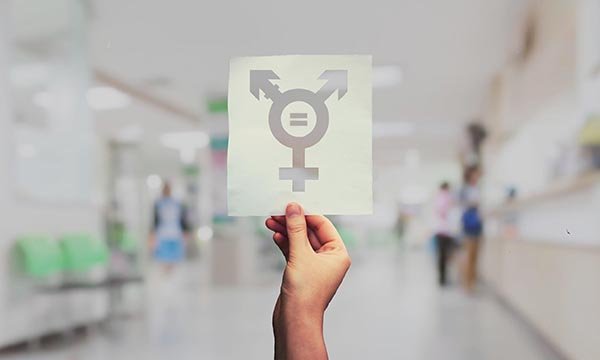Caring for trans and non-binary people: overcoming the fear of ‘getting it wrong’

How nurses can address inequitable treatment and improve communication and outcomes for patients and service users
- Research shows that trans and non-binary people often experience a lack of understanding and prejudice when accessing healthcare
- Terminology used can be important in establishing a meaningful and trusting relationship with a patient or service user
- New RCN guidance aims to increase knowledge of trans and non-binary people's health needs and improve communication in healthcare interactions

Concern over saying the wrong thing, combined with a lack of training, is preventing nurses from giving the best care to people who are transgender or non-binary, according to a new RCN resource.
Trans people’s gender identity is not the same as the sex on their original birth certificate, while non-binary people do not consider themselves to have a solely male or female gender identity.
Overcoming barriers and dealing with specific health needs
East and North Hertfordshire NHS Trust equality and diversity lead Anne Wells is among the co-authors of an updated edition of the college’s guidance on ‘fair care’ for trans and non-binary patients and service users.
Some of the specific health needs of trans and non-binary people are also included in the RCN guidance, including breast awareness, bone protection and smoking cessation – topics where nurses can support people in making healthy choices (see box).
Ms Wells says: ‘The complexity of terminology and a fear of getting it wrong are some of the barriers preventing nursing staff from feeling confident in working with trans people.’
A shortage of useful guidance and services structured along binary gender lines are also preventing effective, individualised care delivery, Ms Wells says.
Health promotion for trans and non-binary people
The RCN guide on fair care for trans and non-binary patients suggests the following areas where nurses can promote health and encourage patients to make healthy choices.

Prostate cancer
Although the risk of prostate cancer is lower in non-binary and trans people, those with a prostate need to be made aware of the continued risk of prostate cancer.

Bone protection
Hormone replacement therapy for trans women can increase the risk of osteoporosis.

Breast awareness
Because breast cancer can be hormone-related, all trans patients and service users should be encouraged to be breast-aware and examine their breasts with the same frequency as other women. Following breast reduction surgery, trans men have a lower risk profile but breast awareness remains important.

Smoking cessation
Hormone therapy also places trans women at increased risk of venothrombolic events, so nurses should offer cessation advice at every opportunity.

Healthy drinking
Patients experiencing social isolation may be at risk of excess alcohol consumption, so guidance on healthy drinking should be provided.
Sexual health
Trans people are at the same risk of sexually transmitted diseases as other sexually active individuals.

Cervical cancer
Trans and non-binary patients with a cervix remain at risk and may not be recalled automatically for screening.
Health services are failing to support trans people
The RCN guide aims to help staff respond more effectively to the needs of those who identify as trans or non-binary.
‘Gender transition has a profound impact on individuals, and it’s important that professionals can think beyond the broad concepts of diversity to understand the needs of this complex group,’ says Ms Wells.
Research quoted in the guidance indicates that trans people are often failed by health services.
A 2016 report by the House of Commons Women and Equalities Select Committee found the NHS was failing to uphold zero tolerance of transphobic behaviour.
‘Trans people encounter significant problems in using general NHS services, due to the attitude of some clinicians and other staff who lack knowledge and understanding – and in some cases are prejudiced,’ the report said.
The National LGBT Survey of 2018 reached similar conclusions, with nearly 40% of respondents reporting a negative experience of healthcare services because of their gender identity.
Many respondents also complained of inappropriate questioning by staff, which ties in with a section on confidentiality in the RCN guidance.
This reminds healthcare professionals that disclosing without permission a patient’s status or history as trans or non-binary is in some cases a criminal offence.
Positive, inclusive experiences of healthcare: my advice for nurses
Jane Hamlin says her experience of health services has been overwhelmingly positive since she transitioned nearly ten years ago.
Ms Hamlin is president of the Beaumont Society, a national self-help group run by and for the transgender community.

‘From the moment I first went to see my GP until the present I’ve always been treated with the same consideration and respect as when people didn’t realise I was trans,’ she says.
Friends and acquaintances have reported different, less helpful experiences, but most of those go back a few years, Ms Hamlin suggests.
‘Things probably have improved,’ she says.
She is understanding of nurses who make the odd slip when caring for trans patients. ‘There are so many things to think about in nursing that it wouldn’t be surprising if not all nurses as aware as they might be.’
What would you expect from a consultation with a nurse?
‘I would hope it would proceed as it would for anybody else – that I would be greeted as I presented myself,’ Ms Hamlin says.
‘I’ve been through the whole reassignment process. I have lived as a woman for the last nine and a half years and in medical settings have always been treated in that way.
‘It’s about accepting people as they are.’
‘Non-binary people don’t identify either way and don’t want to identify either way. But society demands they have an “M” or an “F” on their passport or driving licence. It’s non-binary people who are perhaps most sensitive and least considered’
Jane Hamlin, president of the Beaumont Society
In terms of how to address a trans or non-binary person, she refers to the recent RCN guidance, which says: ‘Begin by introducing yourself with your name and pronouns [see Glossary, below]. You can then politely and discretely ask the person for their name and pronouns.’
‘It’s all in the document, which I find encouraging,’ says Ms Hamlin.
But phone consultations can cause issues.
‘This is a problem that trans women in particular face, and trans men who haven’t gone onto testosterone, when their voice doesn’t appear to match the name they give.
‘Trans women hate being addressed as “sir” when they’ve said, “My name is Jane” and the person they’re talking to continues to call them “sir”. And of course, vice versa for trans men.’
Undressing to prepare for an assessment or procedure can be an issue for some patients, particularly if, for example, they do not intend to transition but are wearing underwear not designed for the sex they were assigned at birth.
But Ms Hamlin’s advice for nurses is simply to ‘act as if it’s perfectly normal – as I’m sure most nurses would anyway’.
Apologise and let it go if you make a mistake
It is also important to remember that gender dysphoria is not necessarily something a patient either has or does not have.
‘It’s possible to have it in all sorts of degrees,’ she says. ‘Most people understand those who genuinely feel they’ve been given the wrong body and want to transition and change it.
‘That’s easier to understand than those in the middle, including non-binary people, who don’t identify either way and don’t want to identify either way. But society demands they have an “M” or an “F” on their passport or driving licence. It’s non-binary people who are perhaps most sensitive and least considered.’
As for making a mistake when caring for a trans person – using the wrong title or pronoun, for example – Ms Hamlin advises nurses to apologise and let it go.
‘Even friends who’ve known me a long time and known me as Jane for nearly ten years occasionally slip up, especially if they’re talking about the past.
‘So, it’s easy to make a mistake but as long as you just correct it, say sorry and move on, not make a big deal out of it, I’m sure no one would be offended.’
Equitable service delivery for trans and non-binary people
The RCN resource says effective and equitable service delivery depends on a positive and proactive approach to trans and non-binary people.
They should be welcomed to the care setting and treated with the same respect as any other patient or client.
But the language and terminology used by staff can help to establish a meaningful and trusting relationship with a patient – or not.
The RCN guidance includes a glossary of relevant terms, an edited version of which is shown below.
Cisgender, non-binary, genderqueer: an overview of terms

This list is not exhaustive but offers an overview of terms that nurses may encounter when caring for trans and non-binary people.
Cisgender: a person whose gender identity and biological sex assigned at birth align (for example, man and male-assigned).
Female-to-male (FtM, F2M): individuals assigned female at birth who are changing, or who have changed, their body and/or gender role from birth-assigned female to a more masculine body or role. A common term to describe this is trans man.
Gender dysphoria: distress caused by a discrepancy between a person’s gender identity and that person’s sex assigned at birth (and the associated gender role).
Gender fluid: views gender identity as a changing mix of male and female.
Gender identity: a person’s intrinsic sense of being male (boy or man), female (girl or woman) or an alternative gender – for example, transgender, girlboy, boygirl, eunuch, genderqueer.
Genderqueer: a term that may be used by individuals whose gender identity does not conform to a binary understanding of gender as limited to the categories of exclusively male or female. Also used as an umbrella term for many gender non-conforming or non-binary identities (for example, agender, bigender, genderfluid).
Gender-neutral pronouns: appropriate pronouns for many non-binary people, such as they/them. These can also be used to avoid referring to someone as ‘he/him’ or ‘she/her’.
Gender reassignment surgery: genital reconstructive surgery to change primary and/or secondary sex characteristics to affirm a person’s gender identity.
Gender role or expression: terms used to describe characteristics in personality, appearance and behaviour which, in a given culture and time, are designated as masculine and feminine (that is, more typical of the male or female social role). All people tend to incorporate masculine and feminine elements in their gender expression.
Gender variance: tends to be used (often in respect of children or adolescents) to refer to behaviour and interests that are outside what is considered ‘normal’ for a person’s assigned (biological) sex. The abbreviation ‘trans’ is sometimes adopted.
Intersex: describes individuals born with variations in their reproductive or sex characteristics that do not fit standard definitions of male or female. Sometimes this is evident at birth and other times it is not apparent until adulthood. Intersex is not a type of trans identity.
Male-to-female (MtF, M2F, MTF): describes individuals assigned male at birth who are changing or who have changed their body and/or gender role from birth-assigned male to a more feminine body or role. A common term to describe this is trans woman.
Non-binary gender: refers to individuals who do not fit within the two distinct categories of exclusively male or female. This term may be used by people who identify outside the gender binary of being exclusively a man or woman, without being any more specific about how they identify.
Trans or transgender: terms to describe a diverse group of individuals who cross or transcend culturally defined categories of gender. The gender identity of transgender people differs to varying degrees from the sex they were assigned at birth.
Trans feminine: individuals assigned male at birth who are proposing to change, or are in the process of changing, or who have changed their body and/or gender role from birth-assigned male to a more feminine body and gender role. This includes trans women and people assigned male at birth who are genderqueer or have another non-binary gender identity.
Trans masculine: individuals assigned female at birth who are proposing to change, or are in the process of changing, or who have changed their body and/or gender role from birth-assigned female to a more masculine body and gender role. This includes trans men and people assigned female at birth who are genderqueer or have another non-binary gender identity.
Transition: the period during which individuals change from the gender role associated with their sex assigned at birth to a different gender role. For many, this involves learning how to live socially in the ‘other’ gender role; for others, it means finding a gender role and expression that is most comfortable for them. Transition may or may not include feminisation or masculinisation of the body through hormones or other medical procedures. The nature and duration of transition is variable and individualised.
Ze/hir: alternate pronouns that are gender-neutral and may be preferred by some trans people. Pronounced ‘zee’ and ‘here’, they replace ‘he’ and ‘she’ and ‘his’ and ‘hers’ respectively. Alternatively, others may use the plural pronouns ‘they/their’ as a gender-neutral singular pronoun to replace ‘he/she’.
Adapted from the RCN’s Fair Care for Trans and Non-Binary People
Find out more
